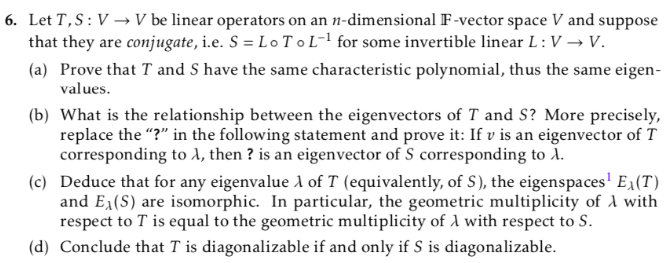6. Let T,S:V→V be linear operators on an n-dimensional F-vector space V and suppose that they are conjugate, i.e. S = Lo T o L-1 for some invertible linear L : V → V. (a) Prove that T and S have the same characteristic polynomial, thus the same eigen values. (b) What is the relationship between the eigenvectors of T and S? More precisely replace the "?" in the following statement and prove it: If v is an eigenvector of T corresponding to 1, then ? is an eigenvector of S corresponding to À. (c) Deduce that for any eigenvalue 1 of T (equivalently, of S), the eigenspaces' E1(T and E1(S) are isomorphic. In particular, the geometric multiplicity of 1 with respect to T is equal to the geometric multiplicity of 1 with respect to S.
6. Let T,S:V→V be linear operators on an n-dimensional F-vector space V and suppose that they are conjugate, i.e. S = Lo T o L-1 for some invertible linear L : V → V. (a) Prove that T and S have the same characteristic polynomial, thus the same eigen values. (b) What is the relationship between the eigenvectors of T and S? More precisely replace the "?" in the following statement and prove it: If v is an eigenvector of T corresponding to 1, then ? is an eigenvector of S corresponding to À. (c) Deduce that for any eigenvalue 1 of T (equivalently, of S), the eigenspaces' E1(T and E1(S) are isomorphic. In particular, the geometric multiplicity of 1 with respect to T is equal to the geometric multiplicity of 1 with respect to S.
Linear Algebra: A Modern Introduction
4th Edition
ISBN:9781285463247
Author:David Poole
Publisher:David Poole
Chapter4: Eigenvalues And Eigenvectors
Section4.6: Applications And The Perron-frobenius Theorem
Problem 27EQ
Related questions
Question

Transcribed Image Text:6. Let T,S:V → V be linear operators on an n-dimensional F-vector space V and suppose
that they are conjugate, i.e. S = Lo T oL-! for some invertible linear L : V → V.
(a) Prove that T and S have the same characteristic polynomial, thus the same eigen-
values.
(b) What is the relationship between the eigenvectors of T and S? More precisely,
replace the "?" in the following statement and prove it: If v is an eigenvector of T
corresponding to A, then ? is an eigenvector of S corresponding to i.
(c) Deduce that for any eigenvalue A of T (equivalently, of S), the eigenspaces' E1(T)
and E1(S) are isomorphic. In particular, the geometric multiplicity of A with
respect to T is equal to the geometric multiplicity of 1 with respect to S.
(d) Conclude that T is diagonalizable if and only if S is diagonalizable.
Expert Solution
This question has been solved!
Explore an expertly crafted, step-by-step solution for a thorough understanding of key concepts.
Step by step
Solved in 3 steps

Knowledge Booster
Learn more about
Need a deep-dive on the concept behind this application? Look no further. Learn more about this topic, advanced-math and related others by exploring similar questions and additional content below.Recommended textbooks for you

Linear Algebra: A Modern Introduction
Algebra
ISBN:
9781285463247
Author:
David Poole
Publisher:
Cengage Learning

Elementary Linear Algebra (MindTap Course List)
Algebra
ISBN:
9781305658004
Author:
Ron Larson
Publisher:
Cengage Learning

Linear Algebra: A Modern Introduction
Algebra
ISBN:
9781285463247
Author:
David Poole
Publisher:
Cengage Learning

Elementary Linear Algebra (MindTap Course List)
Algebra
ISBN:
9781305658004
Author:
Ron Larson
Publisher:
Cengage Learning